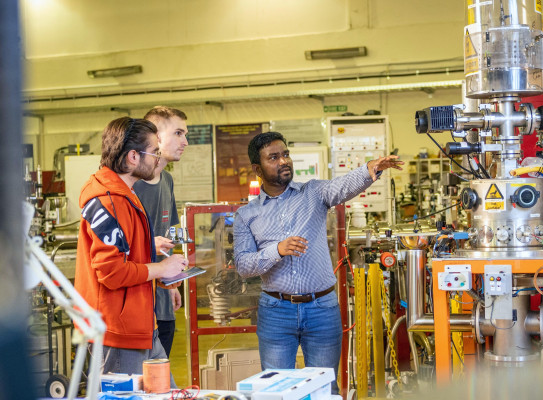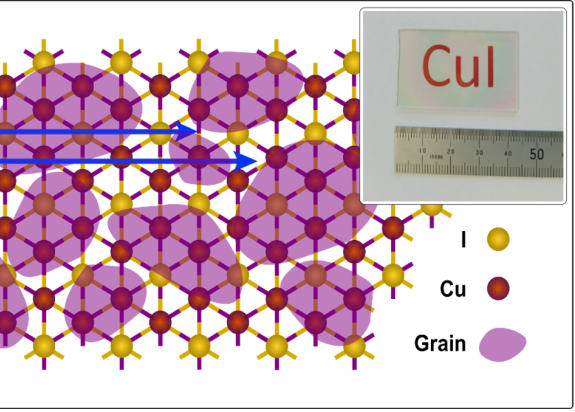
Transparent thermoelectric material

Our objective for this project was to develop efficient thermoelectric coatings and design energy-harvesting windows for buildings.
Overview
GNS Science is exploring cutting-edge technology to generate electricity from windows, which will significantly reduce carbon emissions and household energy bills.
The project aims to
- create a clear coating for windows that can generate clean electricity to power appliances
- assist in reducing carbon emissions and provide a more affordable, sustainable alternative energy source from temperature gradient due to heating and cooling of the buildings
- provide window material that can be installed in new and old buildings without affecting the transparency of the glass
To achieve these objectives, we will
- work closely with manufacturers in Aotearoa New Zealand to encourage uptake of the technology for commercialisation
The project
Transparent window coatings to generate electricity
Did you know that electricity can be generated by converting temperature differences into voltage? A device called a thermocouple is used, which has a different temperature on each side. We are looking at ways to use this ‘clean’ electricity to provide alternative energy sources that will reduce household and office energy bills and address carbon emissions.
This project was a three-year collaboration aiming to create an efficient and novel transparent thermoelectric material that can be coated on to windows to harvest electricity. The coatings would exploit temperature differences between the indoor and outdoor environment to produce the electricity used for indoor heating and cooling.
New Zealand homes have approximately 4.5 million square metres of glass panels and windows, meaning the coatings could have wide-reaching benefits locally, as well as internationally.
A key challenge in year one of the project was to develop a coating material that had thermoelectric properties, but that was also transparent enough to be used on windows. We aimed to build a proof-of-concept window-type device for energy harvesting and test it under simulated conditions, then measure key parameters such as output power density, optical transparency and efficiency.
We demonstrated thermoelectric coatings of wide bandgap semiconductors such as copper iodide and indium-tin-oxide. Doping these materials with suitable elements led to simultaneous improvement of the Seebeck coefficient and electrical conductivity which yielded a high power factor. Our window design showed viable power output for running small electrical appliances.

Our strategy of doping induced an increase of thermoelectric properties in transparent thermoelectric materials that will benefit the global material science research community and enhance the performance of energy harvesting materials.
Our researchers worked in collaboration with local and international partners including Victoria University of Wellington, National Institute of Materials Science (Japan), Rensselaer Polytechnic Institute (USA), and BRANZ Ltd, and New Zealand glass manufacturers.
In the future we intend to work with Māori businesses and others who may have the potential to take up the new technology.
-
Publications
- Murmu, P.P., Karthik, V., Chong, S.V., Rubanov, S., Liu, Z., Mori, T., Yi, J., Kennedy, J. 2021. Effect of native defects on thermoelectric properties of copper iodide films, Emergent Materials, 4 (3): 761-768. DOI: 10.1007/s42247-021-00190-w
- Kennedy, J., Murmu, P.P., Kumar, P., Ramanath, G. 2021. Multifold enhancements in thermoelectric power factor in isovalent sulfur doped bismuth antimony telluride films, Materials Research Bulletin 142: 111426. DOI: 10.1016/j.materresbull.2021.111426
- Murmu, P.P., Karthik, V., Liu, Z., Jovic, V., Mori, T., Yang, W.L., Smith, K.E., Kennedy, J.V., 2020. Influence of carrier density and energy barrier scattering on a high Seebeck coefficient and power factor in transparent thermoelectric copper iodide, ACS Applied Energy Materials, 3 (10): 10037-10044. DOI: 10.1021/acsaem.0c01724
- Murmu, P.P., Shettigar, A., Chong, S.V., Liu, Z., Goodacre, D., Jovic, V., Mori, T., Smith, K.E., Kennedy, J. 2021. Journal of Materiomics 7 (3): 612-620. DOI: 10.1016/j.jmat.2020.10.015

Research project details
Collaborators: The Materials team at GNS Science, Victoria University of Wellington, National Institute of Materials Science (Japan), Rensselaer Polytechnic Institute (USA), and BRANZ Ltd, New Zealand glass manufacturers.
Duration
2018–2021
Funding platform
Endeavour Fund
Status
Completed
Programme leader
Peter Murmu, GNS Science
Funder
Ministry of Business, Innovation & Employment (MBIE)